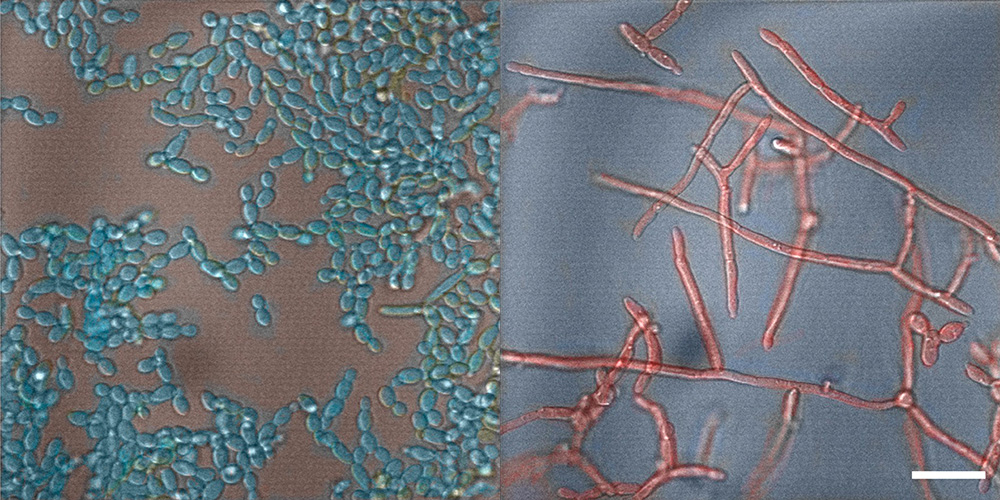Mucus molecules can thwart fungal infection
Candida albicans is a yeast that colonizes the mucosal surfaces of most healthy humans. Under certain conditions, it can switch to a harmful form and cause infection. Researchers have now identified components of mucus that keep the pathogen from turning destructive, thus laying the foundation for a new class of drugs.
07 June 2022
Most people don’t ever notice that they carry potentially harmful pathogens. The fact that they remain ignorant of Candida albicans is in part thanks to a substance usually not very highly regarded: mucus. The slimy liquid covering all mucosal surfaces of the body keeps this yeast in check. However, which components of mucus are responsible for its pathogen-thwarting properties has remained unclear.
An international team of researchers including Dr. Rachel Hevey from the University of Basel and Katharina Ribbeck from the Massachusetts Institute of Technology (MIT) has now identified these components: complex sugar molecules referred to as glycans. As the scientists report in Nature Chemical Biology, specific glycans can suppress so-called filamentation of Candida albicans and other virulence-related traits, which are a hallmark of infection.
The sugar in mucus
Glycans are a major constituent of mucins, the gel-forming polymers that make up mucus. Mucins contain hundreds of different glycans, and a growing body of research suggests that these specialized sugar molecules can help tame specific pathogens.
To test which of the several hundred glycans found in mucus interact with Candida albicans, the team of researchers analyzed and compared the molecular composition of different mucus samples that suppressed filamentation. Among the glycans most abundant in all samples, Hevey and her team at the Department of Pharmaceutical Sciences synthesized six for further analysis.
“Individual glycans are nearly impossible to isolate from mucus samples with current technologies”, says Hevey. “The only way to study the characteristics of individual glycans is to synthesize them, which involves extremely complicated and lengthy chemical procedures.” She and her colleagues are among only a small number of research groups worldwide who are developing methods to synthesize these complex molecules.
Ribbeck and her team at the MIT, were then able to test and confirm the effects of the glycans on Candida albicans. Combined with the team’s previous and ongoing work on other pathogens, the researchers are convinced that glycans may be the key to a novel class of antifungal drugs. “The picture that is emerging is that mucus displays an extensive small-molecule library with lots of virulence inhibitors against all sorts of problematic pathogens, ready to be discovered and leveraged,” Ribbeck says.
Not just for “sliminess”
In its harmful form, Candida can cause conditions such as oral thrush, vaginal yeast infections, or even worse, a life-threatening systemic infection, which affects the blood, heart, and other parts of the body, with a fatality rate of approximately 40%. There are very few antifungal drugs available and these infections remain a challenge to treat.
“There is a dire need for new antifungal drugs”, says Hevey. “For a long time, glycans were thought to only be there for the ‘sliminess’ of mucus. Now we see that they could actually pave the way for novel much-needed drugs against problematic pathogens.” The team is currently exploring ways to deliver mucin glycans to different areas of the body.
The recent discoveries were made possible through a network of researchers with expertise in unique areas, including Prof. Micheal Tiemeyer (Complex Carbohydrate Research Center, University of Georgia), Prof. Clarissa Nobile (University of California at Merced), Prof. Richard Cummings (Harvard Medical School), and Prof. Daniel Wozniak (Ohio State University).
The research was funded by the Swiss National Science Foundation, the National Institutes of Health, the National Science Foundation, and the U.S. Army Research Office through the Institute for Collaborative Biotechnologies.
Original publication
Julie Takagi et al.
Mucin O-glycans are natural inhibitors of C. albicans pathogenicity.
Nature Chemical Biology (2022), doi: 10.1038/s41589-022-01035-1
Further information
Dr. Rachel Hevey, University of Basel, Department of Parmaceutical Sciences, phone: +41 79 133 11 64, email: rachel.hevey@unibas.ch



